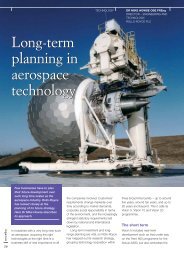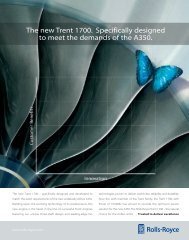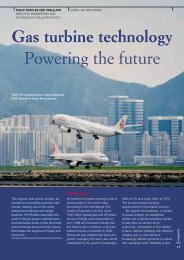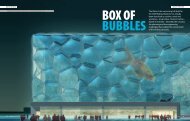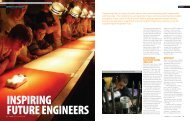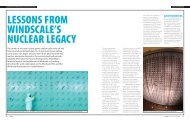[442-07] Newton - Ingenia
[442-07] Newton - Ingenia
[442-07] Newton - Ingenia
Create successful ePaper yourself
Turn your PDF publications into a flip-book with our unique Google optimized e-Paper software.
MANUFACTURING<br />
Why use the X-ray<br />
technique?<br />
Why use X-rays? Why visualise<br />
multiphase systems? If this article were<br />
concerned with medical applications<br />
then the answer to the first question<br />
would be self-evident. It is almost<br />
inconceivable, certainly in the Western<br />
world, to confirm or diagnose many<br />
medical conditions, from broken bones<br />
to lung tumours, without some form of<br />
X-ray imaging technology.<br />
In chemical engineering, as in many<br />
industrial processes, a technique that<br />
enables characterisation, and provides<br />
detailed information, of flow patterns<br />
inside reactor vessels or transfer lines<br />
would be highly desirable and extremely<br />
beneficial. Eminent researchers have<br />
highlighted the problems encountered<br />
by chemical engineers in predicting<br />
multiphase flow behaviour. Derek<br />
Geldart 5 considered that ‘the arrival<br />
time of a space probe travelling to<br />
Saturn can be predicted more<br />
accurately than the behaviour of a<br />
fluidised bed reactor’. And G. F. Hewitt 6<br />
stated: ‘multiphase flows are often<br />
extremely complex in nature and many<br />
of the relationships used for multiphase<br />
flows are of an essentially empirical<br />
nature, are of limited applicability, and<br />
reflect the poor physical understanding<br />
of many two-phase flow phenomena’.<br />
X-ray imaging can be used both as a<br />
diagnostic tool – to help identify the<br />
cause of the ‘problem’ and also to help<br />
formulate the ‘solution’ to that problem<br />
– and as a way of understanding<br />
multiphase flow phenomena and their<br />
relevance to commercial operational<br />
parameters. In the context of chemical<br />
engineering, the images are usually<br />
taken from reactor mock-ups, pilot<br />
plants or pieces of process equipment<br />
operating at, or as close as possible to,<br />
realistic process conditions. This can<br />
mean performing experiments at<br />
elevated temperatures and pressures,<br />
with real-scale process hardware and<br />
catalyst systems.<br />
Although the theoretical aspects of<br />
many multiphase flow phenomena are<br />
described by empirical correlations, it is<br />
clear that the application of many of<br />
these correlations for industrial<br />
exploitation can be somewhat uncertain.<br />
We found such uncertainties during early<br />
work on the X-ray facility at UCL in the<br />
1980s. The object of the investigation<br />
was to test the jet penetration lengths<br />
from horizontal and vertical orientated<br />
nozzles for use in a fluid catalytic<br />
cracking (FCC) regenerator unit.<br />
The objective of the FCC process is<br />
to use both catalytic and thermal<br />
cracking to convert heavy hydrocarbons<br />
(high molecular weight) into lower<br />
molecular weight compounds – usually<br />
boiling in the gasoline and middle oil<br />
ranges. The cracking reactions are<br />
endothermic and are accompanied by<br />
carbon deposition on the solid catalyst<br />
surface. The FCC process has one<br />
location for the absorption of heat, the<br />
reaction and carbon deposition, referred<br />
to as the riser, and a second location<br />
where the deposited carbon is burnt off<br />
and heat is released, referred to as the<br />
regenerator unit. The heat is then<br />
returned to the first location to drive the<br />
reaction, and the circulation of the solid<br />
catalyst particles is the means by which<br />
heat is transported around the unit. The<br />
only way this can be done efficiently is<br />
by employing one or more fluidised<br />
beds.<br />
Many traditional modelling<br />
techniques determine the gas and<br />
solids flow properties of fluidised beds<br />
in small- or medium-scale perspex or<br />
glass equipment operating at ambient<br />
conditions, with measurements made<br />
through viewing screens or with the aid<br />
of sensors placed in the bed.<br />
Observations are not only restricted but<br />
often distorted by the presence of<br />
internal surfaces or from effects of<br />
scale-down. Consequently, most jet<br />
penetration lengths measured by such<br />
techniques fail to detect interactions<br />
between adjacent nozzles or pipes<br />
because of the stabilising effects of the<br />
viewing screens. With X-ray imaging,<br />
such limitations do not exist and unique<br />
information that cannot be obtained by<br />
other techniques is generated.<br />
Figure 3 shows how wall effects can<br />
influence the measurements of gas jet<br />
penetration lengths in fluidised beds.<br />
Initially a nozzle was placed close to the<br />
vessel wall, made from perspex, and<br />
the jet penetration lengths were<br />
Figure 3: Vertical jet penetration for hindered and unhindered nozzles<br />
ingenia<br />
49


![[442-07] Newton - Ingenia](https://img.yumpu.com/23411218/3/500x640/442-07-newton-ingenia.jpg)


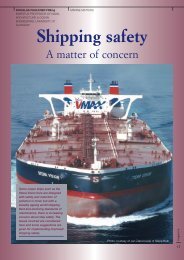


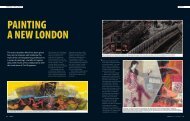
![[322/03] Francke - Ingenia](https://img.yumpu.com/23411337/1/184x260/322-03-francke-ingenia.jpg?quality=85)

